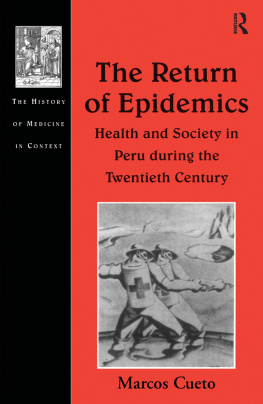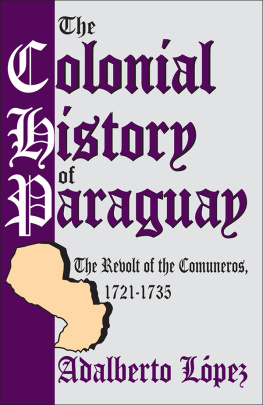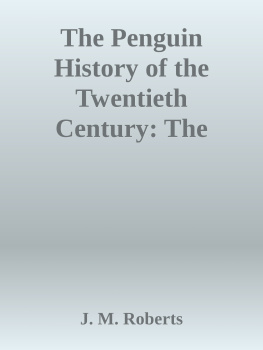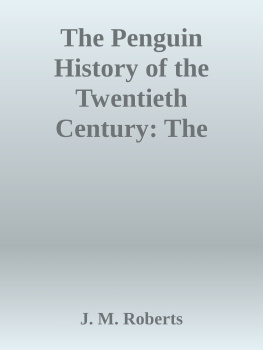This book was published with the assistance of the Lilian R. Furst Fund of the University of North Carolina Press.
2014 THE UNIVERSITY OF NORTH CAROLINA PRESS
All rights reserved. Set in Calluna by codeMantra.
Manufactured in the United States of America
The paper in this book meets the guidelines for permanence and durability of the Committee on Production Guidelines for Book Longevity of the Council on Library Resources. The University of North Carolina Press has been a member of the Green Press Initiative since 2003.
Library of Congress Cataloging-in-Publication Data
Necochea Lpez, Ral.
A history of family planning in twentieth-century Peru / Ral Necochea Lpez.
pages cm
Includes bibliographical references and index.
ISBN 978-1-4696-1808-1 (pbk : alk. paper) ISBN 978-1-4696-1809-8 (ebook)
1. Family planningPeruHistory20th century. I. Title.
HQ766.5.P4N43 2014
363.9609850904dc23
2014017085
Portions of chapter 6 are drawn from Priests and Pills: Catholic Family Planning in Peru, 19671976. Latin American Research Review 43, 2 (2008): 3456. Used with permission.
18 17 16 15 14 5 4 3 2 1
Acknowledgments
Associated Medical Services, Inc., the Social Sciences and Humanities Research Council of Canada, the UNC Institute for the Study of the Americas, and the Department of Social Medicine at the University of North Carolina at Chapel Hill funded the research for this project. I gratefully acknowledge the generosity of these organizations.
Numerous archives and individuals made their collections available to me during the time that it took to research and write this book. The complete list appears in the bibliography section. I would like to extend particular thanks to Dr. Carmen Delgado de Thays, Dr. Miguel Ramos Zambrano, Mrs. Graciela de Leidinger, Dr. Irene Santolalla Silva, Dr. Joseph Kerrins, and Mrs. Helen Kerrins for sharing materials with me that are not open to the general public. Likewise, every conversation I had with the people I interviewed made me realize just how much more there is still to be said about this topic. Some meetings were instrumental in finding needed clues for the story; others challenged me to keep my poise despite unsettling revelations; yet others made me realize I had received the wonderful gift of a friendship. Thanks to this project, I now count Consuelo Castillo, Fr. John Coss, Helen and the late Dr. Joe Kerrins, and Dr. Marie-Franoise Hall among my friends.
Spirited intellectual trade with many people went into the writing of this book. Steve Vallas and Marcos Cueto first inspired me to follow my nose with the idea of family planning in Peru. It was a great privilege to work and play at McGill University with Andrea Tone, Catherine LeGrand, George Weisz, and the lovely miscreants of the basement of the Department of Social Studies of Medicine, including Nomi Tousignant, Loes Knaapen, Hannah Gilbert, Pierre Minn, Drte Bemme, Ari Gandsman, Jennifer Cuffe, Wilson Will, Hanna Kienzler, and Karine Peschard. Many others have helped me clarify my own ideas and contributed new ones along the way, particularly Stephanie Olsen, Lucho van Isschot, Lynn Morgan, Vinh-Kim Nguyen, Myron Echenberg, Jorge Lossio, Nuntxi Iguiiz, Roger Guerra-Garca, Tasha Kimball, Anne-Emanuelle Birn, Barbara Brookes, Maren Klawiter, Nathan Moon, Hannes Toivanen, Hyungsub Choi, Maggie Zegarra, Gisela Delgado, Michael McVaugh, and Gabriela Soto Laveaga. Cees Van Dijk translated from the Latin and Chelly Richards provided some research assistance at a crucial time. The sterling team at the UNC Press, especially Elaine Maisner, Alison Shay, Liz Gray, Dino Battista, Kim Bryant, and Paul Betz, guided me expertly as a novice author, and the presss two reviewers added helpful finishing touches.
I am lucky to be at the University of North Carolina at Chapel Hill for many reasons, foremost among them my gifted and lighthearted colleagues in the Department of Social Medicine. Conversations with Barry Saunders, Mara Buchbinder, Gail Henderson, Jon Oberlander, Sue Estroff, Eric Juengst, Annie Lyerly, Jeffrey Sonis, Deborah Porterfield, Stuart Rennie, Rebecca Walker, and the late Alan Cross have made me see the study of history as the beginning of something much greater and socially transformative. The seriousness with which the UNC School of Medicine treats its mission to care for the people of the state and to train physicians fills me with optimism, as does the warm welcome I have had from the Department of History and the exciting new partnerships that have sprouted with the Gillings School of Global Public Health and the Department of Anthropology. Heartfelt thanks to Lloyd Kramer, Fitz Brundage, Miguel La Serna, Jerma Jackson, Kathryn Burns, Cynthia Radding, Michelle King, Lou Prez, Clare Barrington, Krista Perreira, Trude Bennet, Michelle Rivkin-Fish, Jocelyn Chua, and Peter Redfield.
My family is the best, and no words can express my gratitude and love for Lucy, Edgar, Alejandro, Lauren, Elsy, Flora, Ral, Antuco, Ginucha, my cousins, aunts, uncles, nieces, and nephews, imprescindibles e impresentables. Last but not least, I thank Erica, Toms, and Ansel. I am smitten by you and honored to be in your lives.
A History of Family Planning in Twentieth-Century Peru
Introduction
I cheered in 1995 when Peruvian president Alberto Fujimori gave a speech as the only male head of state at the Fourth World Conference on Women in Beijing.
Yet, once more swung the pendulum when it became apparent that there was more to the story than powerful agencies and physicians victimizing poor, illiterate, indigenous, rural women. The same newspapers that brought the abuses to light reported details that made guilt seem less than straightforward. The Catholic Church, today an opponent of all contraceptive methods, had been behind many of the accusations of forced sterilization. Were the accusations less credible because of that association? Moreover, some local politicians lamented that sterilizations occurred in a country that they considered underpopulated. How did they determine such want of population? Physicians themselves were perplexed by accusations of abuse, as they believed they acted according to the standards of their profession in securing informed consent from women and in performing the surgeries. Finally, at least some of the women who had undergone the surgeries were satisfied with the outcomes. Not only had those women agreed to the operations voluntarily, but they had even traveled in search of the free-of-charge surgeries when these were not performed near their places of residence.
Family planning has long been a contentious issue in Peru, and the book you are reading is about why this is so. Even today, the prevalence of modern contraceptive use in Peru hovers around 50 percent, a rate among the lowest in the Americas, next to that of Guyana (40 percent), Guatemala (34 percent), The implementation of the first family planning programs in developing countries in the mid-twentieth century led to a rapid and understandable colonization of the field by policymakers, health and education activists, and demographers. Family planning, after all, involved changes in health care systems, the adoption of novel technologies, retraining of human resources, conflicts with existing religious institutions, and winning the trust of populations wary of the concept of contraception. Throughout the developing world, family planning held the promise of giving lay people a greater degree of control over their sexual and reproductive lives, and countries a host of opportunities to boost their economic fortunes through the management of population growth. It is no wonder the first and most poignant writings on family planning, as you will see later in this book, were aimed at defending and attacking specific technologies, ideas, and people. The stakesthe future of gender relations, individual autonomy, and national economieswere huge.







